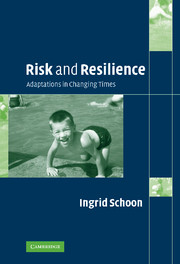Book contents
- Frontmatter
- Contents
- List of figures
- List of tables
- Foreword by Glen H. Elder, Jr
- Preface by John Bynner
- Acknowledgements
- Introduction
- 1 Risk and resilience: definitions
- 2 Towards a developmental-contextual systems model of adjustment
- 3 Persisting inequalities in times of social change
- 4 Selection, causation and cumulative risk effects
- 5 Protective factors and processes
- 6 Stability of early adjustment over time
- 7 Personal goals and life plans
- 8 Conclusions and outlook
- 9 Implications of findings for interventions and social policy
- Appendix A Two British birth cohorts
- Appendix B Response rates and handling of missing data
- Appendix C Description of variables used in the study
- References
- Index
5 - Protective factors and processes
Published online by Cambridge University Press: 22 September 2009
- Frontmatter
- Contents
- List of figures
- List of tables
- Foreword by Glen H. Elder, Jr
- Preface by John Bynner
- Acknowledgements
- Introduction
- 1 Risk and resilience: definitions
- 2 Towards a developmental-contextual systems model of adjustment
- 3 Persisting inequalities in times of social change
- 4 Selection, causation and cumulative risk effects
- 5 Protective factors and processes
- 6 Stability of early adjustment over time
- 7 Personal goals and life plans
- 8 Conclusions and outlook
- 9 Implications of findings for interventions and social policy
- Appendix A Two British birth cohorts
- Appendix B Response rates and handling of missing data
- Appendix C Description of variables used in the study
- References
- Index
Summary
The first duty of a state is to see that every child born therein shall be well housed, clothed, fed, and educated, till it attain years of discretion.
John Ruskin, 1867Although there is a strong relationship between exposure to cumulative adversity and developmental outcomes, the relationship is by no means deterministic. There is considerable diversity in the way in which individuals respond to adversity or hardship, and many young people growing up in socio-economically disadvantaged families go on to lead rewarding and well-adjusted lives (Garmezy, 1991; Werner & Smith, 1992; Werner & Smith, 2001). The identification of individuals who are able to transcend exposure to adversity and who appear to avoid developing later adjustment problems, raises important issues regarding the factors and processes that lead to this resilience. The study of resilience not only entails the identification of individuals who succeed in the face of adversity but also the search for potential antecedents of such varying pathways, the protective factors and processes that mitigate, exacerbate or mediate the risk associated with adverse socio-economic conditions. The aim of this chapter is to identify protective factors and processes facilitating academic resilience in early childhood, as levels of early academic attainment are especially important in shaping later academic trajectories.
Studies have taken a variety of approaches in their attempt to identify factors associated with positive adjustment in the face of adversity and then to understand the process that underlay positive adjustment.
- Type
- Chapter
- Information
- Risk and ResilienceAdaptations in Changing Times, pp. 74 - 93Publisher: Cambridge University PressPrint publication year: 2006



